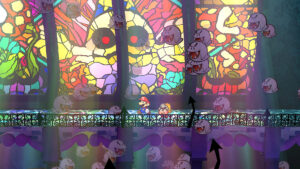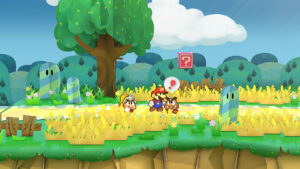Last year, a certain Super Mario RPG returned to Nintendo Switch. A complete remake of a SNES game whose notoriety continued to rise until its return to our modern platforms. A remake allowing as many people as possible to be able to play it comfortably. Furthermore, at a certain time the development of a sequel to Super Mario RPG was planned for Nintendo 64, a sequel which would ultimately completely change its name to become the Paper Mario license. A first opus published on Nintendo 64 followed by a sequel on Nintendo Gamecube. Like Super Mario RPG, Paper Mario: The Millennium Door, initially released on Nintendo Gamecube, is about to to come back this year on Nintendo Switch to mark its 20th anniversary and we have already had the chance to touch on this version to tell you about it today.
Mario presents his papers a second time on Nintendo Switch
The most attentive and fans of the license have certainly noted the fact that on Nintendo Switch, we already had a certain Paper Mario: The Origami King. An opus that failed to make an impact on the community by choosing to be a good adventure game experience and a bad role-playing game. For many fans, one of the last unanimous representatives of the Paper Mario license remains the Gamecube opus that we have in our hands today on Nintendo Switch. Should we talk about Remake or Remaster? For Nintendo, we are definitely on a Remake and without mentioning the story that we are saving for next time, we can affirm at first glance that the visual work is very far from a Remaster.
Advertisement
There is real visual work taking up the style of the most recent opuses to give a real facelift to the original game released on Gamecube. The expressions of the characters, their contours and more generally the paper/cardboard style production is more successful than ever. Without forgetting, the work on the colors as well as on the much finer and cleaner rendering than in the original version. Players with very good eyes and a better technical appreciation will note from the start the regression of the framerate, going from 60fps on Gamecube to 30fps on Nintendo Switch. However, during the time we were able to play, the framerate seemed very stable and it would really be like throwing away unused paper for no reason to dwell on this detail in order to sanction the game.
In addition, technically, the game seemed to hold up very well in both the living room and portable, so what more could you ask for? Just that everything holds up across the whole game and it will be our job to check that. Another thing that we will have to check will concern the contributions to this Nintendo Switch version in terms of gaming experience. At the start of the game that we were able to do, it is still difficult to list all the new features. But we can, however, reassure you that the basic mechanics of the original game are very present. Paper Mario: The Millennium Door is an RPG with its linear progression, its annexes, its city or dungeon explorations as well as its turn-based combat. During the exploration phases, we can pursue our objectives or take the opportunity to make our preparations.
In other words, it is possible to visit stores to purchase items, sell items or even store them. There is also a points system to motivate you to make purchases like a loyalty card system similar to those existing in real life. Beyond purchases and the pursuit of our goals, we can just explore the decor out of pure curiosity through its “paper” creation. The game seems to motivate this exploration by rewarding the player with objects and secrets to unlock in addition to potentially being surprised to reach a corner of the city by discovering that we get there by passing through a fold of paper for example.
As we progressed, we seemed to be able to unlock powers linked to the theme of the paper to go ever further and always remain captivated by the imagination of the developers. This even though the game is 20 years old and we are just waiting to see if any additions exist to bluff us even more. Exploration is quite peaceful in town, apart from a few events linked to the scenario. On the roads or in the dungeons we have visible enemies and like in a classic RPG, coming into contact with them takes us to a combat scene.
Advertisement
 The transition is fluid and we did not use our terms randomly since we are literally on a theater stage with the red curtains, the audience, but also and above all our protagonists on one side and the enemies on the other. The classic turn-based system asks us to choose our action to see it performed live. The possible actions depend on the character in our combat group. Take the example of Mario who could attack by jumping or using his hammer. We could also use objects or use strategies like escaping. Goomelie, our first ally, could attack on a whim or analyze our enemies to provide us with information about them.
The transition is fluid and we did not use our terms randomly since we are literally on a theater stage with the red curtains, the audience, but also and above all our protagonists on one side and the enemies on the other. The classic turn-based system asks us to choose our action to see it performed live. The possible actions depend on the character in our combat group. Take the example of Mario who could attack by jumping or using his hammer. We could also use objects or use strategies like escaping. Goomelie, our first ally, could attack on a whim or analyze our enemies to provide us with information about them.
A particularity of the system that we already had in the original game is the system of dynamic interactions in the middle of combat to boost our offensives. Let's take the example of Mario again; by pressing the jump button at the moment of impact with the enemy, we could follow up with a second jump in addition to boosting the damage inflicted. These dynamic interactions were offered to us both during our offensives and when we had to defend ourselves. A mechanic that has often been reused in RPG-type Mario games and even in the remake of Super Mario RPG previously released on Nintendo Switch. Like the other points, we have barely touched on the game to be able to fully discuss the potential additions of this remake related to the combat system.
On the other hand, if the action/adventure direction of recent games scares you, don't worry about the possible additions, they do not seem to distort the RPG experience of the original game. Something not difficult to guess by noting that the turn-based combat system is maintained, but we also and always have the progression of our characters by level by gaining experience and improving certain stats. An RPG dimension that has been lost over time and the pleasure of finding all that in Paper Mario through this remake is undisguised. To accompany this first brief contact with the game, we notice the music reworked in the style of Super Mario RPG for the greatest pleasure of our ears, with the auditory rediscovery that results from it.
